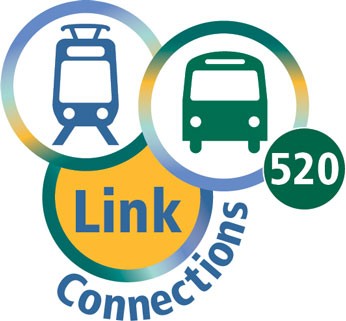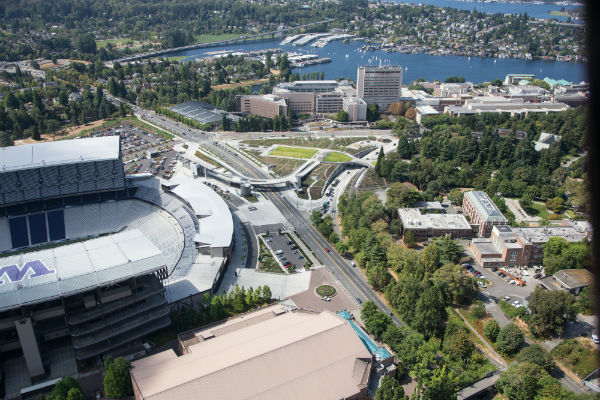Future Connections Across 520 Bridge

Next steps on the future of Eastside-downtown Seattle bus service
Metro and Sound Transit recently asked for customer input on two concepts for improving bus service across State Route 520. Our concepts would restructure bus service to and from the Eastside to connect at Husky Stadium with fast, reliable Link light rail into downtown. The changes would help keep people moving as major construction and worsening congestion make the commute to and from downtown Seattle longer and less reliable.
The savings from sending fewer buses into downtown would be re-invested into expanded service, more frequency and new direct connections to destinations such as South Lake Union.
This summer, we invited the public to weigh in during a second phase of outreach. Our online survey drew 2,500 responses, and another 90 people attended our open houses. The Link Connections SR-520 Sounding Board, made up of 21 community volunteers, also provided feedback during regular meetings.
This feedback will be used to develop a single proposal to be presented to the public in spring 2018. Any changes in service could be implemented as early as 2019. Visit our Link Connections SR-520 website for more information.
What we asked during outreach
Routes under review include Metro Routes 252, 255, 257, 268, 277, and 311, and ST Express Routes 540, 541, 542, and 545.
With no changes, bus service likely will get slower and less on time due to rapid growth and increased traffic. In addition, the Downtown Seattle Transit Tunnel will be closed to buses in 2019, moving routes such as the 255 to congested surfaces streets.
In our first round of outreach, customers told us they wanted buses to come more often, run later on weeknights and weekends, and connect to new destinations. In response, Metro and Sound Transit developed three service concepts that aim to keep riders moving through congestion and to improve transit in the SR-520 corridor.
They can generally be described as:
- Option A: Maintain existing routes, with future congestion
(Learn more about Option A here)
- Option B: Connects routes to Link, re-invests resources in added Frequency
(Learn more about Option B here)
- Option C: Connects routes to Link, re-invests resources in New Connections.
(Learn more about Option C here)
What we heard from the public
Two key themes emerged from public feedback.
First, people are open to transferring to light rail for a more convenient and more reliable commute. They also want more frequent, reliable service and less overcrowding during peak periods. They also liked the idea of direct service to South Lake Union.
Secondly, people want a seamless transfer between buses and light rail. People had concerns about giving up their “one-seat ride” and wanted more information about what it will look like for customers to regularly transfer between the train and bus at the Montlake Triangle.
Some of their concerns:
- Traffic from the Montlake Boulevard exit off of SR-520 and at the Montlake Triangle.
- Ensuring Link light rail has room for additional riders at UW
- Transit capacity during Husky games and other big events.
- Impact of Montlake Bridge openings on bus service
- Walking distance between the light rail platform and bus stops, especially for seniors and people with disabilities
- Exposure to rain and elements.
- Extra time needed to transfer to and from Link
- Transfers between bus and Link for cash-paying customers.

How this feedback will shape our next steps
Metro and Sound Transit are working with the Seattle Department of Transportation and University of Washington on plans for improvements to make the bus-rail transfer as convenient and seamless as possible. This work is continuing and more information is expected in coming months. The public will have an opportunity next spring to review a refined proposal before it goes to the King County Council and Sound Transit Board of Directors for review.
How to stay involved
We appreciate the thousands of people who took time to share their feedback and look forward to your continued participation in the future. Please subscribe to receive updates by email or text about the next opportunity to participate.
How we informed the public
- Press release, ethnic media outreach
- Social media
- Metro Have a Say website, blog post and Sound Transit website
- E-notifications: route subscribers, community partners, employers– (24,000+ notices)
- Bus rack cards, posters at high-ridership stops
- Street Teams/info tabling – (5,000 information cards were distributed)
How people provided feedback during Phase II
- Peak Democracy online engagement tool – (nearly 2,500 responses)
- Sounding Board – (22 members representing the communities affected by the restructure)
- Emails and phone calls
- At in-person outreach events, i.e. Open Houses and Street Teaming, etc. (Phase II – six events with an average attendance of 25 people)
- Stakeholder briefings and meetings (employers, cities, stakeholder groups)
Who we heard from
Survey respondents included communities served by the routes and those who use each of the 10 routes included in the service concepts. We heard from a nearly equal number of people who ride the two highest ridership routes, Route 255 serving Kirkland, and Route 545, serving Redmond.
More than half said they were traveling to the northern end of downtown Seattle, about one-third said they were traveling to the southern end of downtown Seattle. Redmond, Kirkland, and the UW were the next most popular destination, followed by Bellevue, north Kirkland, Capitol Hill, and South Lake Union.
Demographics
- About 73 percent identify as white or Caucasian
- 12 percent identify as Asian or Pacific Islander
- 1 percent identify as Black or African-American
- 3 percent Hispanic, Latino, or Spanish, 1 percent American Indian or Alaska Native, 3 percent multiple ethnicities, and 1 percent “other”.
- 13 percent reported a disability, with 5 percent reporting the disability affected their mobility